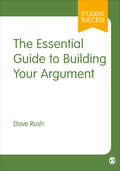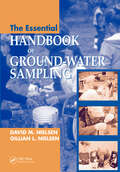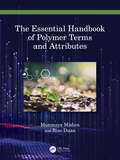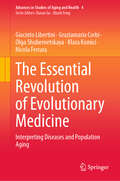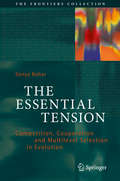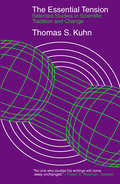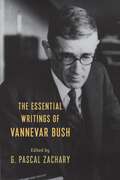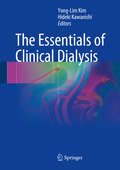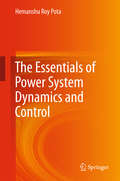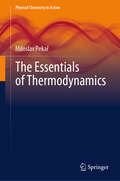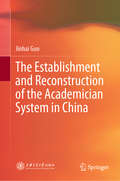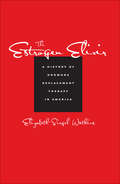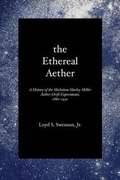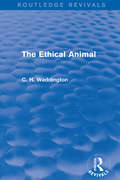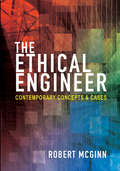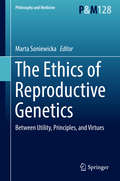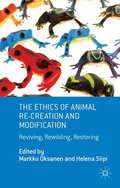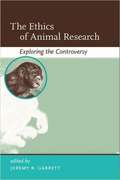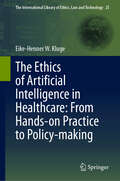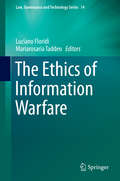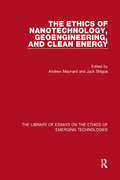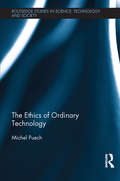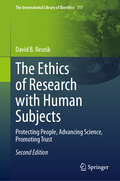- Table View
- List View
The Essential Guide to Building Your Argument (Student Success)
by Dave RushStruggling to know why arguments are important at university? Unsure about what an argument is, how they work, or how to produce one? Then you have come to the right place! Covering both written and verbal arguments, this practical guide will demystify academic conventions. It will show you what an argument is and how it works, providing you with a framework for producing great arguments of your own. Student Success is a series of essential guides for students of all levels. From how to think critically and write great essays to boosting your employability and managing your wellbeing, the Student Success series helps you study smarter and get the best from your time at university.
The Essential Handbook of Ground-Water Sampling
by David M. Nielsen Gillian NielsenTremendous improvements in ground-water sampling methodologies and analytical technologies have made it possible to collect and analyze truly representative samples to detect increasingly lower levels of contaminants-now in the sub-parts-per-billion range. Though these new methods produce more accurate and precise data and are less expensive, many
The Essential Handbook of Polymer Terms and Attributes
by Biao Duan Munmaya K MishraThe Essential Handbook of Polymer Terms and Attributes not only acts as an encyclopaedia of polymer science but also fosters an appreciation for the significance of polymers in fields including materials science, chemistry, engineering, and medicine. This book serves as an excellent reference book, covering every possible term and attribution associated with the vast and diverse field of polymers. This comprehensive volume serves as a vital resource for researchers working in industry and academia, offering a clear and concise exploration of polymer science with the most essential reference data available. Each polymer term is defined in a straightforward manner, ensuring that readers of all levels can grasp the concepts. The book goes beyond mere definitions, providing context and insights into the applications, properties, and synthesis. Bringing polymer terms and attributes together in one place, the book provides a broad knowledge of polymer science and facilitates idea generation for researchers and students embarking on projects related to a specific field of polymer science. Key features: This book covers all possible terms associated with the field of “polymers" and related areas, granting readers a comprehensive understanding of the entire spectrum of polymers. The organization of the book follows an alphabetical format, enabling quick and convenient access to specific terms. Each polymer term is clearly defined with a figure or scheme as needed, allowing readers to visualize the structures, processes, and applications involved. This book is written for science students, chemists, polymer scientists, chemical engineers, pharmaceutical scientists, biomedical scientists, biotechnologists, product formulators, materials scientists, and scientists working on polymers.
The Essential Revolution of Evolutionary Medicine: Interpreting Diseases and Population Aging (Advances in Studies of Aging and Health #4)
by Giacinto Libertini Graziamaria Corbi Olga Shubernetskaya Nicola Ferrara Klara KomiciThis book proposes a way to radically renew medicine by extending to medicine the concepts of evolutionary biology. The book considers diseases not as unpredictable harmful events but as logical consequences of evolutionary mechanisms. In particular, a large part of the most widespread diseases that afflict modern populations are interpreted as the consequence of discordances (mismatches) between new living conditions and the adaptation of our species. It discusses the basic concepts, as well as diseases deriving from alterations of the genotype and general concepts about diseases deriving from alterations of the ecological niche. It also describes diseases deriving from relations with other living beings especially when the ecological niche is altered, diseases deriving from conditions beyond the adaptation range, and physiological phenomena that cause troubles and suffering or even death. A particular study is dedicated to the interpretation of aging and its consequences in normal or altered conditions of the ecological niche. The final part of the book describes the implementation of evolutionary medicine. This book, complementing the "Evolutionary Gerontology and Geriatrics" book, which is also published in this series, provides a valuable read for scholars and students in the fields of medicine, evolutionary biology, preventive medicine, and gerontology.
The Essential Tension
by Sonya Bahar'The Essential Tension' explores how agents that naturally compete come to act together as a group. The author argues that the controversial concept of multilevel selection is essential to biological evolution, a proposition set to stimulate new debate. The idea of one collective unit emerging from the cooperative interactions of its constituent (and mutually competitive) parts has its roots in the ancient world. More recently, it has illuminated studies of animal behavior, and played a controversial role in evolutionary biology. In Part I, the author explores the historical development of the idea of a collectivity in biological systems, from early speculations on the sociology of human crowd behavior, through the mid-twentieth century debates over the role of group selection in evolution, to the notion of the selfish gene. Part II investigates the balance between competition and cooperation in a range of contemporary biological problems, from flocking and swarming to experimental evolution and the evolution of multicellularity. Part III addresses experimental studies of cooperation and competition, as well as controversial ideas such as the evolution of evolvability and Stephen Jay Gould's suggestion that "spandrels" at one level of selection serve as possible sources of variability for the next higher level. Finally, building on the foundation established in the preceding chapters, the author arrives at a provocative new proposition: as a result of the essential tension between competition and cooperation, multiple levels may be essential in order for evolutionary processes to occur at all.
The Essential Tension: Selected Studies in Scientific Tradition and Change
by Thomas S. Kuhn"Kuhn has the unmistakable address of a man, who, so far from wanting to score points, is anxious above all else to get at the truth of matters."—Sir Peter Medawar, Nature
The Essential Writings of Vannevar Bush
by Vannevar BushThe influence of Vannevar Bush on the history and institutions of twentieth-century American science and technology is staggeringly vast. As a leading figure in the creation of the National Science Foundation, the organizer of the Manhattan Project, and an adviser to Presidents Roosevelt and Truman during and after World War II, he played an indispensable role in the mobilization of scientific innovation for a changing world. A polymath, Bush was a cofounder of Raytheon, a pioneer of computing technology, and a visionary who foresaw the personal computer and might have coined the term “web.”Edited by Bush’s biographer, G. Pascal Zachary, this collection presents more than fifty of Bush’s most important works across four decades. His subjects are as varied as his professional pursuits. Here are his thoughts on the management of innovation, the politics of science, research and national security, technology in public life, and the relationship of scientific advancement to human flourishing. It includes his landmark introduction to Science, the Endless Frontier, the blueprint for how government should support research and development, and much more. The works are as illuminating as they are prescient, from considerations of civil-military relations and the perils of the nuclear arms race to future encyclopedias and information overload, the Apollo program, and computing and consciousness. Together, these pieces reveal Bush as a major figure in the history of science, computerization, and technological development and a prophet of the information age.
The Essentials of Clinical Dialysis
by Yong-Lim Kim Hideki KawanishiThisbook is a thorough guide to dialysis that will assist in the effectivetreatment of patients. Current knowledge on all aspects of dialysis, includingthe most recent advances, is presented and the various techniques used indialysis patients are described step by step. Both hemodialysis and peritonealdialysis are fully considered. The coverage of hemodialysis explains theprocedure and its indications and provides guidance on challenging topics suchas vascular access, response to acute and chronic complications, and on-linehemodiafiltration. The discussion of peritoneal dialysis includes explanation ofperitoneal physiology, the principles of prescription, and the treatment ofperitonitis and exit site infection. A summary of updated dialysis-relatedguidelines is included at the end of the book. The lucid text is supported bymore than 200 full-color illustrations that clarify anatomy,vascular/peritoneal access, and dialysis procedures and techniques. The Essentialsof Clinical Dialysis will be of value for all who are involvedin the management of dialysis patients and will be a helpful guide for trainingof physicians and healthcare associates in the dialysis center.
The Essentials of Power System Dynamics and Control
by Hemanshu Roy PotaThis book presents a general framework for modelling power system devices to develop complete electromechanical models for synchronous machines, induction machines, and power electronic devices. It also presents linear system analysis tools that are specific to power systems and which are not generally taught in undergraduate linear system courses. Lastly, the book covers the application of the models, analysis and tools to the design of automatic voltage controllers and power system stabilisers, both for single-machine-infinite-bus systems and multi-machine interconnected systems.In most textbooks modelling, dynamic analysis, and control are closely linked to the computation methods used for analysis and design. In contrast, this book separates the essential principles and the computational methods used for power system dynamics and control. The clear distinction between principles and methods makes the potentially daunting task of designing controllers for power systems much easier to approach.A rich set of exercises is also included, and represents an integral part of the book. Students can immediately apply—using any computational tool or software—the essential principles discussed here to practical problems, helping them master the essentials.
The Essentials of Thermodynamics (Physical Chemistry in Action)
by Miloslav PekařThis monograph offers a unique approach to understanding thermodynamics by blending practical experience, a mathematically rigorous foundation, and historical insights. It presents the evolution of thermodynamics, demonstrating that the functions, equations, relationships, and quantities didn't simply materialize but were rooted in the human experience of heat and cold. While equilibrium thermodynamics is the primary focus, time is integrated as a fundamental element, distinguishing this from traditional treatments. Readers will find familiar heat-related experiences transformed into model equations, revealing the natural emergence of fundamental thermodynamic concepts. These essentials are then distilled into simple axioms summarizing the core principles of equilibrium thermodynamics. The book goes beyond macroscopic descriptions, delving into microscopic connections at the atomic and molecular levels. It is suitable for a diverse readership, including students in science and technology, professionals looking to refresh their knowledge of thermodynamics, and those interested in exploring advanced, non-equilibrium thermodynamics. While it caters to a broad audience, it is particularly beneficial for individuals in chemistry and chemical engineering, requiring only a basic understanding of calculus.
The Establishment and Reconstruction of the Academician System in China
by Jinhai GuoThis book is the first monograph to study the processes of establishing and reconstructing the academician system, and the landmark events in the history of science and technology in 20th century China. It also provides new insights to help us understand the process of scientific institutionalization in modern China. Drawing on detailed archive records, it discusses the process of the establishment of the Academia Sinica's academician system in the Republic of China, as well as the unique and tortuous transformation process from members of the Academic Divisions(学部委员)to academicians of the Chinese Academy of Sciences(中国科学院)in the People's Republic of China. These play an important part of China's modernization process, and reflect scientific institutionalization in China. The book also highlights the fact that under the leadership of the government, the academic elite became participants in the construction of national academic system after the founding of the People's Republic of China.
The Estrogen Elixir: A History of Hormone Replacement Therapy in America
by Elizabeth Siegel WatkinsIn the first complete history of hormone replacement therapy (HRT), Elizabeth Siegel Watkins illuminates the complex and changing relationship between the medical treatment of menopause and cultural conceptions of aging. Describing the development, spread, and shifting role of HRT in America from the early twentieth century to the present, Watkins explores how the interplay between science and society shaped the dissemination and reception of HRT and how the medicalization—and subsequent efforts toward the demedicalization—of menopause and aging affected the role of estrogen as a medical therapy. Telling the story from multiple perspectives—physicians, pharmaceutical manufacturers, government regulators, feminist health activists, and the media, as well as women as patients and consumers—she reveals the striking parallels between estrogen’s history as a medical therapy and broad shifts in the role of medicine in an aging society.Today, information about HRT is almost always accompanied by a laundry list of health risks. While physicians and pharmaceutical companies have striven to develop the safest possible treatment for the symptoms of menopause and aging, many specialists question whether HRT should be prescribed at all. Drawing from a wide range of scholarly research, archival records, and interviews, The Estrogen Elixir provides valuable historical context for one of the most pressing debates in contemporary medicine.
The Ethereal Aether: A History of the Michelson-Morley-Miller Aether-Drift Experiments, 1880-1930
by Loyd S. SwensonThe Ethereal Aether is a historical narrative of one of the great experiments in modern physical science. The fame of the 1887 Michelson-Morley aether-drift test on the relative motion of the earth and the luminiferous aether derives largely from the role it is popularly supposed to have played in the origins, and later in the justification, of Albert Einstein's first theory of relativity; its importance is its own. As a case history of the intermittent performance of an experiment in physical optics from 1880 to 1930 and of the men whose work it was, this study describes chronologically the conception, experimental design, first trials, repetitions, influence on physical theory, and eventual climax of the optical experiment. Michelson, Morley, and their colleague Miller were the prime actors in this half-century drama of confrontation between experimental and theoretical physics. The issue concerned the relative motion of "Spaceship Earth" and the Universe, as measured against the background of a luminiferous medium supposedly filling all interstellar space. At stake, it seemed, were the phenomena of astronomical aberration, the wave theory of light, and the Newtonian concepts of absolute space and time. James Clerk Maxwell's suggestion for a test of his electromagnetic theory was translated by Michelson into an experimental design in 1881, redesigned and reaffirmed as a null result with Morley in 1887, thereafter modified and partially repeated by Morley and Miller, finally completed in 1926 by Miller alone, then by Michelson's team again in the late 1920s. Meanwhile Helmholtz, Kelvin, Rayleigh, FitzGerald, Lodge, Larmor, Lorentz, and Poincaré-most of the great names in theoretical physics at the turn of the twentieth century-had wrestled with the anomaly presented by Michelson's experiment. As the relativity and quantum theories matured, wave-particle duality was accepted by a new generation of physicists. The aether-drift tests disproved the old and verified the new theories of light and electromagnetism. By 1930 they seemed to explain Einstein, relativity, and space-time. But in historical fact, the aether died only with its believers.
The Ethical Animal (Routledge Revivals: Selected Works of C. H. Waddington)
by C. H. WaddingtonFirst published in 1960, this book discusses the ethical implications of the view of man’s nature and his place in the biological world. C. H. Waddington highlights issues of the time, such as social upheavals related to social mobility, and the changing nature of philosophical thinking in relation to the nature of good. The author argues that man differs from all other animals in his ability for social teaching and learning and that this provides him with a second method of evolutionary advance, in addition to biology. He advances this through the idea that man has the capacity to entertain ethical ideas, which is an essential and necessary feature of this new mode of evolution. From here he draws the conclusion that a consideration of the broad trends of evolution provides a framework within which we can rationally discuss the relative merits of the various systems of ethical belief current in the world. In presenting his argument, Waddington draws on research in biology, psychology, the social sciences, and philosophy. He concludes with a short consideration of some of the most important ethical problems facing mankind at the time of the book’s publication.
The Ethical Engineer: Contemporary Concepts And Cases
by Robert McGinnAn exploration of the ethics of practical engineering through analyses of eighteen rich case studiesThe Ethical Engineer explores ethical issues that arise in engineering practice, from technology transfer to privacy protection to whistle-blowing. Presenting key ethics concepts and real-life examples of engineering work, Robert McGinn illuminates the ethical dimension of engineering practice and helps students and professionals determine engineers’ context-specific ethical responsibilities.McGinn highlights the “ethics gap” in contemporary engineering—the disconnect between the meager exposure to ethical issues in engineering education and the ethical challenges frequently faced by engineers. He elaborates four “fundamental ethical responsibilities of engineers” (FEREs) and uses them to shed light on the ethical dimensions of diverse case studies, including ones from emerging engineering fields. The cases range from the Union Carbide pesticide plant disaster in India to the Google Street View project. After examining the extent to which the actions of engineers in the cases align with the FEREs, McGinn recapitulates key ideas used in analyzing the cases and spells out the main lessons they suggest. He identifies technical, social, and personal factors that induce or press engineers to engage in misconduct and discusses organizational, legal, and individual resources available to those interested in ethically responsible engineering practice.Combining probing analysis and nuanced ethical evaluation of engineering conduct in its social and technical contexts, The Ethical Engineer will be invaluable to engineering students and professionals.Meets the need for engineering-related ethics studyElaborates four fundamental ethical responsibilities of engineersDiscusses diverse, global cases of ethical issues in established and emerging engineering fieldsIdentifies resources and options for ethically responsible engineering practiceProvides discussion questions for each case
The Ethical Project
by Philip KitcherPrinciples of right and wrong guide the lives of almost all human beings, but we often see them as external to ourselves, outside our own control. In a revolutionary approach to the problems of moral philosophy, Philip Kitcher makes a provocative proposal: Instead of conceiving ethical commands as divine revelations or as the discoveries of brilliant thinkers, we should see our ethical practices as evolving over tens of thousands of years, as members of our species have worked out how to live together and prosper. Elaborating this radical new vision, Kitcher shows how the limited altruistic tendencies of our ancestors enabled a fragile social life, how our forebears learned to regulate their interactions with one another, and how human societies eventually grew into forms of previously unimaginable complexity. The most successful of the many millennia-old experiments in how to live, he contends, survive in our values today. Drawing on natural science, social science, and philosophy to develop an approach he calls "pragmatic naturalism," Kitcher reveals the power of an evolving ethics built around a few core principles-including justice and cooperation-but leaving room for a diversity of communities and modes of self-expression. Ethics emerges as a beautifully human phenomenon-permanently unfinished, collectively refined and distorted generation by generation. Our human values, Kitcher shows, can be understood not as a final system but as a project-the ethical project-in which our species has engaged for most of its history, and which has been central to who we are.
The Ethics of Reproductive Genetics: Between Utility, Principles, And Virtues (Philosophy and Medicine #128)
by Marta SoniewickaThis book is aimed at analyzing the foundations of medical ethics by considering different moral theories and their implications for judgments in clinical practice and policy-making. It provides a review of the major types of ethical theory that can be applied to medical and bioethical issues concerning reproductive genetics. In response to the debate on the most adequate ethical doctrine to guide biomedical decisions, this book formulates views that capture the best elements in each, bearing in mind their differences and taking into account the specific character of medicine. No historically influential position in ethics is by itself adequate to be applied to reproductive decisions. Thus, this book attempts to offer a pluralistic approach to biomedical research and medical practice. One usually claims that there are some basic principles (non-maleficence, beneficence, confidentiality, autonomy, and justice) which constitute the foundations of bioethics and medical ethics. Yet these principles conflict with each other and one needs some criteria to solve these conflicts and to specify the scope of application of these principles. Exploring miscellaneous ethical approaches as introduced to biomedicine, particularly to reproductive genetics, the book shall elucidate their different assumptions concerning human nature and the relations between healthcare providers, recipients, and other affected parties (e.g. progeny, relatives, other patients, society). The book attempts to answer the question of whether the tension between these ethical doctrines generates conflict in the field of biomedicine or if these competing approaches could in some way complement each other. In this respect, lecturers and researchers in bioethics would be interested in this reading this book.
The Ethics of Animal Re-creation and Modification
by Markku Oksanen Helena SiipiWould it be cool to see woolly mammoth alive one day? Disappeared species have always fascinated the human mind. A new discussion of using genomic technologies to reverse extinction and to help in conservation has been sparked. This volume studies the question philosophically.
The Ethics of Animal Research
by Jeremy R. GarrettAn estimated 100 million nonhuman vertebrates worldwide--including primates, dogs, cats, rabbits, hamsters, birds, rats, and mice--are bred, captured, or otherwise acquired every year for research purposes. Much of this research is seriously detrimental to the welfare of these animals, causing pain, distress, injury, or death. This book explores the ethical controversies that have arisen over animal research, examining closely the complex scientific, philosophical, moral, and legal issues involved. Defenders of animal research face a twofold challenge: they must make a compelling case for the unique benefits offered by animal research; and they must provide a rationale for why these benefits justify treating animal subjects in ways that would be unacceptable for human subjects. This challenge is at the heart of the book. Some contributors argue that it can be met fairly easily; others argue that it can never be met; still others argue that it can sometimes be met, although not necessarily easily. Their essays consider how moral theory can be brought to bear on the practical ethical questions raised by animal research, examine the new challenges raised by the emerging possibilities of biotechnology, and consider how to achieve a more productive dialogue on this polarizing subject. The book's careful blending of theoretical and practical considerations and its balanced arguments make it valuable for instructors as well as for scholars and practitioners.
The Ethics of Artificial Intelligence in Healthcare: From Hands-on Practice to Policy-making (The International Library of Ethics, Law and Technology #25)
by Eike-Henner W. KlugeThis book provides an ethical analysis of the ethical issues that arise in the design, nature and use of AIs as they are currently used in the delivery and planning of healthcare by hands-on healthcare professionals, institutional administrators and social policy makers. It suggests that while these issues overlap, they have distinct aspects in the respective domains. Among other things, it distinguishing between AIs as expert systems as they are currently constituted and AIs as based in quantum computers or as constituted of bio-printed material, indicates how this is evolving and outlines the ethically relevant issues that would then arise.
The Ethics of Information Warfare
by Luciano Floridi Mariarosaria TaddeoThis book offers an overview of the ethical problems posed by Information Warfare, and of the different approaches and methods used to solve them, in order to provide the reader with a better grasp of the ethical conundrums posed by this new form of warfare. The volume is divided into three parts, each comprising four chapters. The first part focuses on issues pertaining to the concept of Information Warfare and the clarifications that need to be made in order to address its ethical implications. The second part collects contributions focusing on Just War Theory and its application to the case of Information Warfare. The third part adopts alternative approaches to Just War Theory for analysing the ethical implications of this phenomenon. Finally, an afterword by Neelie Kroes - Vice President of the European Commission and European Digital Agenda Commissioner - concludes the volume. Her contribution describes the interests and commitments of the European Digital Agenda with respect to research for the development and deployment of robots in various circumstances, including warfare.
The Ethics of Insurgency
by Michael L. GrossAs insurgencies rage, a burning question remains: how should insurgents fight technologically superior state armies? Commentators rarely ask this question because the catchphrase 'we fight by the rules, but they don't' is nearly axiomatic. But truly, are all forms of guerrilla warfare equally reprehensible? Can we think cogently about just guerrilla warfare? May guerrilla tactics such as laying improvised explosive devices (IEDs), assassinating informers, using human shields, seizing prisoners of war, conducting cyber strikes against civilians, manipulating the media, looting resources, or using nonviolence to provoke violence prove acceptable under the changing norms of contemporary warfare? The short answer is 'yes', but modern guerrilla warfare requires a great deal of qualification, explanation, and argumentation before it joins the repertoire of acceptable military behavior. Not all insurgents fight justly, but guerrilla tactics and strategies are also not always the heinous practices that state powers often portray them to be.
The Ethics of Nanotechnology, Geoengineering, and Clean Energy (The\library Of Essays On The Ethics Of Emerging Technologies Ser.)
by Andrew Maynard Jack StilgoeNanotechnology, clean technology, and geoengineering span the scale of human ingenuity, from the imperceptibly small to the unimaginably large. Yet they are united by a commonality of ethics that permeates how and why they are developed, and how the resulting consequences are managed. The articles in this volume provide a comprehensive account of current thinking around the ethics of development and use within each of the technological domains, and addresses challenges and opportunities that cut across all three. In particular, the collection provides unique insights into the ethics of ’noumenal’ technologies - technologies that are impossible to see or detect or conceive of with human senses or conventional tools. This collection will be of relevance to anyone who is actively involved with ensuring the responsible and sustainable development of nanotechnology, geoengineering or clean technology.
The Ethics of Ordinary Technology (Routledge Studies in Science, Technology and Society)
by Michel PuechTechnology is even more than our world, our form of life, our civilization. Technology interacts with the world to change it. Philosophers need to seriously address the fluidity of a smartphone interface, the efficiency of a Dyson vacuum cleaner, or the familiar noise of an antique vacuum cleaner. Beyond their phenomenological description, the emotional experience acquires moral significance and in some cases even supplies ethical resources for the self. If we leave this dimension of modern experience unaddressed, we may miss something of value in contemporary life. Combining European humanism, Anglophone pragmatism, and Asian traditions, Michel Puech pleads for an "ethical turn" in the way we understand and address technological issues in modern day society. Puech argues that the question of "power" is what needs to be reconsidered today. In doing so, he provides a three-tier distinction of power: power to modify the outer world (our first-intention method in any case: technology); power over other humans (our enduring obsession: politics and domination); power over oneself (ethics and wisdom).
The Ethics of Research with Human Subjects: Protecting People, Advancing Science, Promoting Trust (The International Library of Bioethics #111)
by David B. ResnikIn The Ethics of Research with Human Subjects, David B. Resnik, PhD/JD, develops and defends an approach to thinking about ethical and policy dilemmas in research with human subjects based on the notion of trust. The book explains why trust is important not only between investigators and research subjects but also between and among other stakeholders involved in the research enterprise, including research staff, sponsors, institutions, communities, oversight committees, government agencies, and the public. Dr. Resnik argues that trust should be viewed as a distinct ethical principle for research with human subjects that complements other principles, such as respect for human dignity, beneficence, non-maleficence, and justice. The book applies the principle of trust to numerous issues, including informed consent, confidentiality/privacy, risk minimization, risk/benefit assessment, payments for participation, protection of vulnerable subjects, experimental design, research integrity, and research oversight. The book also includes discussions of the history of research involving human subjects, moral theories and principles, contemporary cases, and proposed regulatory reforms. This second edition of The Ethics of Research with Human Subjects expands upon and clarifies arguments and ideas discussed in the first edition and includes new material on emerging issues in human research ethics, including community-based research, citizen science research, challenge studies (including COVID-19 experiments), public health research, genomics research, social and behavioral research, xenotransplantation experiments, alternative study designs, and research with people with compromised decisional capacity, employees, and students. The book is of interest to undergraduate and graduate students who are studying ethical and policy issues related to research with human subjects, as well as scientists and scholars who are interested learning more about the issues and thinking about what it means to promote integrity and trust in research with human subjects.
